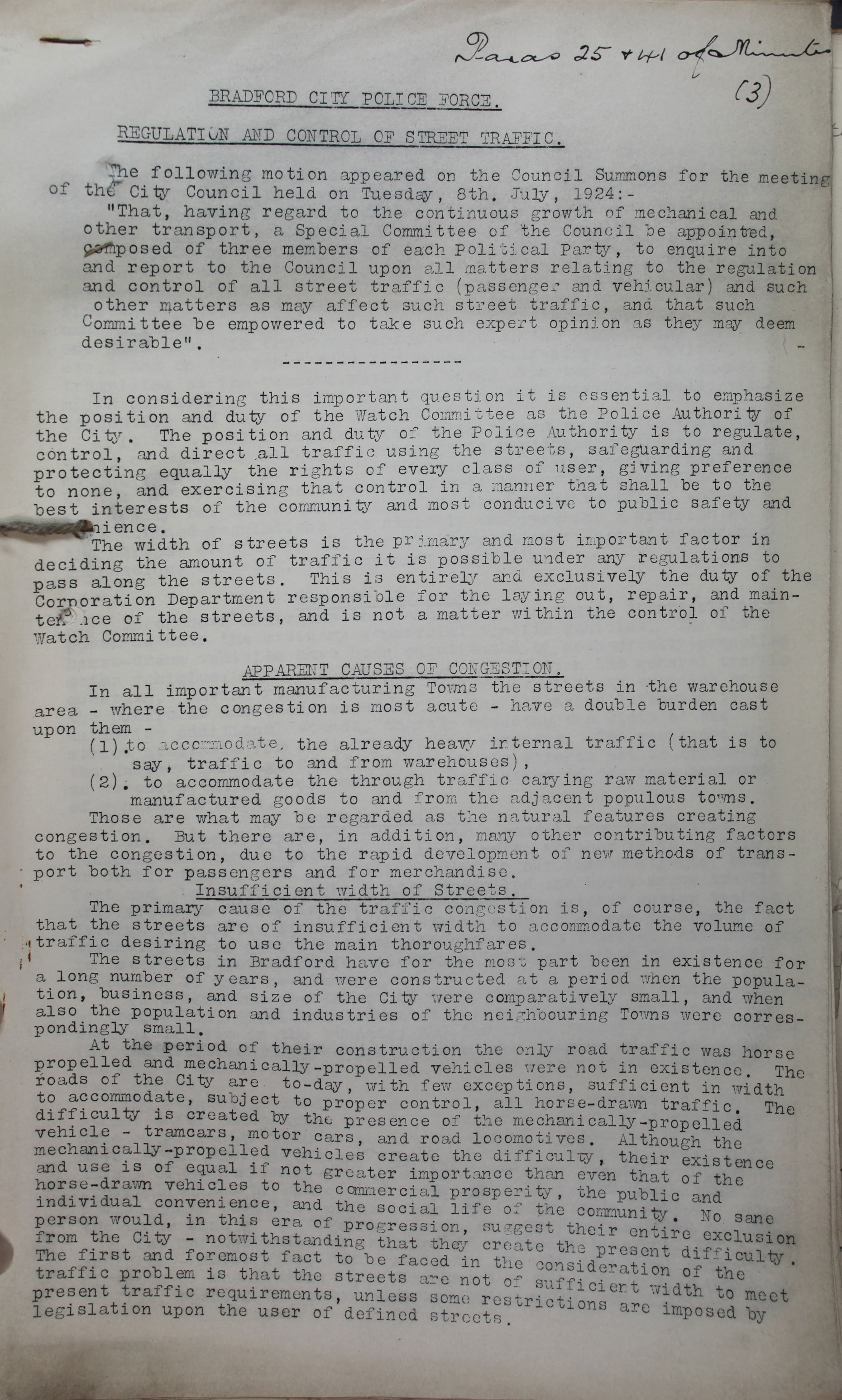
Extract from a Bradford City Police Force Report on regulation and control of street traffic, 17 July, 1924 (Catalogue ref: HO 45/11961)
Transcript
BRADFORD CITY POLICE FORCE
REGULATION AND CONTROL OF STREET TRAFFIC
The following motion appeared on the Council Summons for the City council held on Tuesday, 8th July 1924:-
“That, having regard to the continuous growth of mechanical and other transport, a Special Committee of the Council be appointed composed of three members of each Political Party, to enquire into and report to the Council upon all matters relating to the regulation and control of all street traffic (passenger and vehicular) and such other matters as may affect such street traffic, and such Committee be empowered to take such expert opinion as they may deem desirable”
——————————
In considering this important question it is essential to emphasize the position and duty of the Watch Committee as the Police Authority of the City. The position and duty of the Police Authority is to regulate, protecting equally the rights of every class of user, giving preference to none, and exercising that control in a manner that shall be to the best interests of the community and most conducive to public safety and convenience.
The width of the streets is the primary and most important factor in deciding the amount of traffic it is possible under any regulations to pass along the streets. This is entirely and exclusively the duty of the Corporation Department responsible for the laying out, repair, and maintenance of the streets, and is not a matter within the control of the Watch Committee.
APPARENT CAUSES OF CONGESTION
In all important manufacturing Towns the streets in the warehouse area-where the congestion is most acute-have a double burden cast upon them-
- To accommodate, the already heavy internal traffic (that is to say, traffic to and from warehouses)
- To accommodate the through traffic carrying raw material or manufactured goods to and from the adjacent populous towns. Those are what be regarded as the natural features creating congestion. But there are, in addition, many other contributing factors to the congestion, due to the rapid development of new methods of transport both for passengers and for merchandise.
Insufficient width of Streets
The primary cause of the traffic congestion is, of course, the fact that the streets are of insufficient width to accommodate the volume of traffic desiring to use the main thoroughfares.
The streets in Bradford have for the most part been in existence for a long number of years, and were constructed at a period when population, business, and size of the City were comprehensively small, and when also the population and industries of the neighbouring Towns were correspondingly small.
At a period of their construction the only road traffic was horse propelled and mechanically-propelled vehicles were not inexistence. The roads of the City are today, with few exceptions, sufficient in width to accommodate, subject to proper control, all horse-drawn traffic. The difficulty is created by the presence of the mechanical-propelled vehicles-tramcars, motor cars, and road locomotives. Although the mechanically propelled vehicles create the difficulty, their existence and use is of equal if not greater importance than even that of the horse-drawn vehicles to the commercial prosperity, the public and individual convenience, and the social life of the community. No sane person would, in this era of progression, suggest their entire exclusion from the City- not withstanding that they create the present difficulty. The first and foremost fact to be faced in the consideration of the traffic problem is that the streets are not of sufficient width to meet present traffic requirements, unless some restrictions are imposed by legislation upon the user of defined streets.
…
